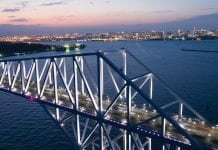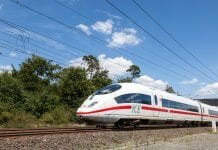
José F. Papí, president of the Smart Transportation Alliance explains how smart mobility is impossible without smart transportation infrastructures.
The smart transportation infrastructures of the future: connecting people and businesses
Our lives are becoming ‘smart’: we enjoy smartphones, our urban environments are evolving into smart cities, and our automobiles are incorporating smart features, assisting our driving and increasing our safety. In this context, smart transportation infrastructures are a key player in a changing world, becoming more competitive and cohesive every day.
With some minor geographical exceptions, in general people and goods will be moving around the globe further and faster. Roads being the essential link in the modal chain, transportation systems will become fully integrated, allowing travellers and freight to switch seamlessly between modes and across borders. All major airports and seaports will connect to the rail network; intermodal terminals for passenger and freight should be ‘smartly’ designed and equipped accordingly. In the case of freight, cooperative systems, seamless trans-shipment and smart route design will lead to the sector’s optimisation.
The world needs smart transportation infrastructures that are able to process the vast amount of information collected in real time and provide the most effective transportation services to businesses and citizens alike.
The role of infrastructures in the smart mobility era
‘Bricks’ infrastructures become smart
New ideas, pioneering strategies and entrepreneurship are needed to respond to this new reality. Thanks to recent technological innovations, such as remote sensing, advance analytics, automated operations, crowdsourcing and integrated scheduling and control, traditional ‘bricks’ infrastructure can now be used more effectively and operated and maintained more efficiently.
The establishment of an integrated transportation ‘info-structure’, relying on V2I (vehicle to infrastructure), I2V (infrastructure to vehicle), V2V (vehicle to vehicle) and I2I (infrastructure to infrastructure) communications – but also on the availability of open and quality transportation data – will provide substantial improvements for the performance of transportation networks and raise its efficiency. At the same time, location-based and traffic-related smart transportation infrastructures will allow robust built-in data privacy and security solutions.
No smart city without smart mobility
All around the world people are thronging cities. 53% of the population currently live in urban areas and by 2050 this number is expected to reach 67%. Countless studies have stood out that most cities are badly equipped to cope with the transportation challenges ahead.
In addition to the increasing demand for urban mobility, needs are evolving. Changing travel habits, demand for services to increase convenience, speed and predictability, as well as evolving customer expectations towards customisation will require more intelligent infrastructure that is able to cope with these extended mobility requirements. The equation is clear: there cannot be a smart city without smart mobility, and no smart mobility is possible without smart transportation infrastructures.
Smart transportation infrastructures – safety and security
When smart is not enough
Transportation accidents remain an ongoing challenge across developed countries and an undeniable major tragedy in developing countries. With very few developing countries devoting proper funding to implement innovative strategies in terms of transportation infrastructure safety management, accidents data is becoming increasingly alarming. For instance, road accidents are expected to become the biggest killer of children between five and 15 years old in sub-Saharan Africa, outstripping malaria and AIDS.
Innovation efforts when designing safer smart transportation infrastructures, as well as when implementing the best possible safety solutions in the maintenance and modernisation of existing ones, will contribute to reduce transportation mortality and injury rates, with a special eye on vulnerable users.
When innovation leads to safety
Innovation in the transportation sector as a whole is usually driven by safety concerns. Either individual events (like ship or aviation incidents) or soaring road deaths figures have led decision-makers to new safety regulations and stimulated innovation. Smart transportation infrastructures are changing this trend now by anticipating risks, but further progress must be made in relation to advanced safety technologies that bring early warning and protection to all transportation users.
Today solutions acting directly on the infrastructure itself are gaining ground, as they bring the advantage of a rapid implementation of smart transportation infrastructures that derives in immediate social benefits. Smart technologies are revolutionising the way cities locate, address and prevent safety issues. Safety monitoring, as well as data collection methods, moves towards non-intrusive and non-destructive inspection and testing systems, including embedded self-monitoring systems.
Natural and man-made disasters: the concept of vulnerability
A sizeable number of transportation infrastructures have been severely impacted by natural disasters inflicted by hurricanes and tsunamis. Additionally, today there are global examples of terrorist acts inflicted on transportation and smart city infrastructures in over 40 countries worldwide, as it appears that public transit has become a new operational theatre for terrorists.
Supplying society with a more secure network of smart transportation infrastructures will decrease their degree of vulnerability to natural and man-made disasters. Additionally, advanced security systems must provide an adequate response and recovery time to all kinds of incidents, and at the same time not hinder the normal flow of passengers and freight, the so-called ‘control in motion’.
Cybersecurity has also become a core aspect of transportation. As several critical services become interconnected, the need for stronger and more advanced cybersecurity surges so as to protect data exchanges, privacy and the health and safety of citizens.
An emotional attribute owed to taxpayers
From a user perspective, smart transportation infrastructures should offer the highest safety and security levels that technology progress allows to date. Citizens and businesses alike want to ‘feel’ transportation infrastructures secure their mobility with the lowest possible risk, both minimising the probability of and mitigating the potential effects of accidents, and in addition providing an adequate response and recovery time to all kinds of incidents. Academia has thoroughly studied this positive attribute of a transportation system: any real or perceived threat activates the so-called ‘commercial fear’, which automatically obstructs both business decisions and the individual freedom of movement.
Bearing the above in mind, investments in safe and secure smart transportation infrastructures are justified not only because they contribute to securing mobility at all times and in all circumstances, but also by the fact that they represent the perfect example of a dual outcome, as agencies avoid making capital investment decisions “with a focus of the cost-benefit analysis being made within a single silo or swim lane” (Bragdon, 2008). In short, the investments made not only provide the required infrastructure, but also a safe and secure logistic scenario that fosters trade and mobility.
Sustainability: green is the new black
More than a challenge, a responsibility
Transportation networks must satisfy high mobility demands, but at the same time must do it with the lowest possible energy consumption and CO2 emissions. At the same time, plenty of innovative recipes are available, even if their market uptake has been quite limited to date.
Solutions to improve infrastructure energy efficiency include the reduction of the energy embodied in the physical structures through reuse and recycling, the implementation of low energy systems and energy harvesting from the infrastructure itself to the extent of self-sufficient production. In addition, the design, maintenance and operation of smart transportation infrastructures can have a substantial influence on the energy consumed by the vehicles, vessels and aircrafts operating on it.
I would also highlight that a better integration of infrastructure in its natural habitat (avoiding fragmentation as much as possible), together with a reduced intrusion of noise, air pollution and vibration, is an ethical responsibility for our modern societies.
Dedicated green corridors using new types of vehicles over medium distances are one of my favourite solutions, as I am not so convinced the market potential (or even the technological viability) of safe automated driving for day-to-day commuter mobility will be realised in the short and medium term.
Last but not least, infrastructures cannot forget to support the soft modes of transport (e.g. cycling and walking) and must supply a sustainable and cross-modal urban transport ecosystem.
Sustainable all the way along
Parameters such as the durability and the reuse and recycling of materials are becoming more relevant in an economic context that demands higher efficiency. At the same time, innovative systems and processes for construction are key to improve sustainability of smart transportation infrastructures worldwide.
Long lasting, climate resilient and more environmentally aware construction materials are also having a growing role in the construction of new corridors and hubs, together with cost-efficient and fast design methods. Self-healing and self-cleaning technologies (e.g. applied to coatings, pavements or bridges) will also enhance faster and better-planned quality control systems.
Towards climate-resilient smart transportation infrastructures
Climate stresses in the recent past involve changes in temperature, precipitation, storm activity, sea level, wind speeds and more. These effects can in turn lead to impacts on transportation infrastructure, such as weakened bridges and road beds, expanded rail tracks, delays and disruption in ports due to sea levels rising or damaged airstrips.
The effects of climate change are real: transportation infrastructure is not always ready to cope with extreme weather conditions, which result in an extra cost to transportation infrastructures. Climate change impacts can be revealed as major incidents that occur more often, or as small and incremental changes that over the years deteriorate and erode the quality of transportation infrastructures.
Adaptation of infrastructure to climate requires taking in account every stage of the management process: planning, design, construction, operation and maintenance of smart transportation infrastructures. Easier said than done, but understanding and proactively addressing the potential impacts of climate stresses can help avoiding the potential damage, disruption in service, and safety concerns that may emerge.
Decision makers must make the most of new and existing transportation infrastructure assets
Transportation investments must also be smart
Today’s global infrastructure demand is estimated at about €3.4 trillion in annual expenditure with a gap – or missed opportunity – of almost €1 trillion every year. Investments must also be smart: spread across modalities, and in addition, based not only on traffic engineering principles, but also on the needs of users and the spatial and economic characteristics of a given region. In short: making the most from the funds invested.
Prioritising smart transportation infrastructures in a robust and bankable project pipeline, accelerating the project preparation process, and selecting the most adequate project delivery model, are some examples of ingredients for a cost-effective recipe. Streamlining the delivery of construction plans, by means of, for instance, establishing comprehensive digital data documenting the full history of an infrastructure, should be developed and disseminated.
Operations and maintenance: pursuing the ‘power of one per cent’ approach
Several studies have shown the positive effect of infrastructure on the national economy; depending on the current infrastructure stock, a 1% increase in infrastructure assets boosts gross domestic product (GDP) by 0.05% to 0.25% in the long-term.
However, while building new smart transportation infrastructures ranks high on the global agenda, operations and maintenance remain as a pending matter. It is crucial to increase the asset productivity and longevity, and therefore, against the backdrop of increasing user demand, constrained financing and an ageing asset base, it is imperative for governments to make the most of their existing infrastructure assets by implementing the most innovative operations and maintenance best practices.
Pursuing the ‘power of one per cent’ can make a dramatic impact, as each percentage point of operations and maintenance optimisation yields more than financial and economic rewards; it will provide social and environmental benefits.
Smart as a shortcut towards transportation funding
Many public infrastructure agencies have outmoded governance structures and procedures, as they are still subject to political influence and weighed down by bureaucracy. Management tools should support project delivery, as well as smart governance tools to analyse the positions of the stakeholders affected and find integrated solutions.
Sophisticated and innovative procurement should be developed, accompanied by adequate monitoring systems, contracting and tendering methods. Coordination across assets and different levels of national, regional and local government should be secured, as well as implementing capacity building programmes that support both public authorities responsible for the provision of services and transport operators.
Transportation competes with health care, sanitation, education, debt service, and numerous other high-priority areas for public funds, leading to the lack of funds allocated to smart transportation infrastructures. Today it is irrefutable that attracting the private sector will be fundamental to fill the existing gap – or missed opportunity.
Visualising smart transportation infrastructures
‘Smart Transportation Infrastructures: A Look into the Future’ is a whiteboard animation presenting the key attributes of the smart transportation infrastructures of the future. The video clip reviews the main challenges towards the deployment of a new generation of transportation infrastructures connecting people and businesses across the world.
I invite you to watch the video at STA’s YouTube channel.
José F. Papí
Founder/CEO
Etelätär Innovation
President
Smart Transportation Alliance, STA
Tweet @Smart_Transp
www.smart-transportation.org


















